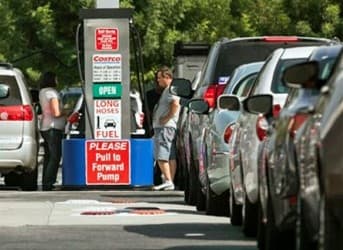Crude oil sourced in the United States is cheaper and therefore means less pain at the pump for American drivers. When adjusted for inflation, however, the price for a gallon of regular unleaded gasoline is still high because of international dynamics, AAA said Monday.
"Cheaper domestic crude has a significant effect on the price most of us pay at the pump," AAA spokesman Michael Green told Oilprice. "U.S. refineries have access to cheaper crude oil than their overseas competitors, which provides a lucrative business advantage."
The U.S. Energy Information Administration said U.S. oil production should hit 9.6 million barrels per day before 2020, the highest level in more than 40 years. Most of the increase in production comes from so-called tight oil formations and EIA said production trends should continue into the next decade.
Related Article: What Happens After the Boom?
Green said prices at the pump have decreased along with increased U.S. oil production. The spring national average for a gallon of regular unleaded in 2011 peaked at $3.98, but shouldn't pass the $3.65 per gallon mark this season. The national average price for Monday was $3.58 per gallon.
"Without the surge in domestic crude oil production and expanded refinery capacity, it is likely that drivers in most parts of the country would be paying at or near $4.00 per gallon this spring for gasoline," Green said.
Only Hawaii and California had state average prices above the $4.00 mark and most of that was because of higher taxes than the other 48 states.
Green said the spread between the price of West Texas Intermediate crude oil, the U.S. benchmark, and Brent, the global benchmark, has been higher than usual at least since February 2012. That means there's an abundance of cheaper oil at home, which makes the U.S. energy market look good compared with the rest of the world.
Nevertheless, market factors beyond the U.S. border are keeping gasoline prices high, relatively speaking. When adjusted for inflation, the $2.09 per gallon reported as a national average this week in 2009 would be $2.29 today. Green said prices are so much more expensive now because demand for energy is increasing in China and other developing nations, which makes oil prices rise in response.
Related Article: Spring Fever Could Lead to Increase in Gas Demand
For U.S. consumers then, AAA said gasoline prices are still considered too expensive despite the shale boom. AAA data show more than half of the people in the country consider $3.50 too much to pay for a gallon of gasoline.
"These results show that despite the increase in domestic production, prices still have not dropped to as low as most people in the public would expect and want," Green said.
ADVERTISEMENT
For the ending March 31, EIA said U.S. drivers paid at least $3.00 per gallon than their European counterparts, however.
By Daniel J. Graeber of Oilprice.com


















